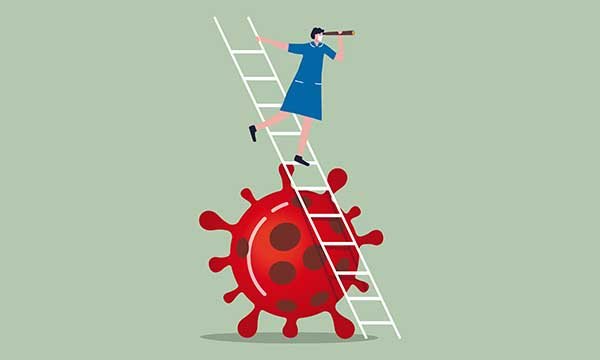A community nurse reflects on changes wrought by the pandemic

Nurse manager Clare Mechen's diary show how the effects of COVID-19 began to unfold and how she and colleagues responded in the early weeks
- Huge changes in work practices, including segregation of patients who are displaying symptoms of coronavirus
- Routine appointments switch to phone calls, leaving the waiting room eerily quiet
- Links with community teams strengthen, the pandemic strikes local care homes

Mid-February
I’ve been watching the world news and seeing the devastation in China caused by this new strain of coronavirus (later named COVID-19). I’m beginning to realise this situation is very real, although I’m still not really believing it will impact the UK.
Early March
The virus is spreading through Italy. The conference of the World Union of Wound Healing Societies in Abu Dhabi has been cancelled because of it and I’m now thinking about how it will affect us all and the NHS.
The following week
I feel devastated at having to temporarily close our booming leg club from 12 March. I could see how upset our members and volunteers were that they won’t be able to socialise. They’ll go back to being isolated and lonely, and we don’t know when we’ll be able to reconvene.
Mid-March
We’re making plans to start reducing routine primary care appointments and move towards telephone appointments. The next few days bring constant changes and every day we’re meeting to review decisions. I feel I’m cocooned in planning for COVID-19 – constantly living with it and feeling exhausted. But the surgery waiting rooms feel spookily quiet.
The operational plan to have red, amber and green zones within the practice, to segregate patients who are displaying symptoms of coronavirus from those who are not, means completely changing the way we work, all within a week. It’s been very challenging.
View our COVID-19 resource centre
I’ve also been meeting with community teams to discuss how we can work in a more integrated way to support the needs of all patients. And I’ve been seeing information from the practice nurse team about skills they may have that could assist district nurse teams.
Working days are long. I’m trying to keep abreast of all the new information coming through government channels but there’s so much to read and it’s changing daily.
25 March
A reality check. I watch the news and a 21-year-old woman with no underlying health problems has died. This all feels very daunting. Watching the news about the devastating events in Italy and being advised that we are only two weeks away from a similar scenario in the UK is absolutely shocking.
The final couple of days of planning are under way for the go-live date for our dedicated ‘hot’ clinic, or red zone, to deal with suspected COVID-19 cases. We’re working through the process of making clinical decisions with only minimal physical contact and following extreme infection prevention and control (IPC) measures.
We are also realigning all our nursing services to function from one site rather than four – not a simple task. But I’m working with an amazing team – nursing, medical and non-clinical colleagues – all of whom are striving to make this new system work.
There are offers of help from many members of my team and a simple smile or text message to ask if I am okay goes a long way towards keeping me sane.
The weekend is spent trying to switch off and recharge but it’s difficult with all the news, plus the arrival of new primary care guidance.
30 March
First day of the new way of working and everyone is trying to get used to the changes. There are some staff concerns about personal protective equipment (PPE) for seeing patients face-to-face in the non-COVID-19 zones, even though this not in Public Health England recommendations. I decided to authorise our nursing staff to have face masks because of the amount of time nurses need to spend with patients – dressing a leg ulcer, for example.
I’m relieved that the ‘hot’ zone is now up and running, with very strict IPC measures. The first patients have been seen in this new controlled environment.
Sadly, one of our nursing team has decided that this will be the end of her career because of the health concerns of her family and the stress the current situation has caused. I don’t think any of us realised how difficult things had been for her.
We all feel devastated that she will end her career without the chance for us to give her a good send-off, but I hope we can remedy that in the future. This certainly highlights the stress and anxiety healthcare professionals are having to deal with during this crisis.
2 April
Finally some further guidance around PPE in primary care, but it’s open to interpretation. PPE has become a hot topic with lots of discussion around the details.
With our commitment to ensure all staff are safe and protected when undertaking face-to-face consultations, we’ve calculated we need approximately 650 full sets of PPE per week to be able to continue to deliver our service.
With stocks still not flowing easily, our main question is how we are going to ensure we stay safe.
For the rest of the week the main emphasis for everyone is on trying to obtain adequate supplies. I start to feel like the character Del Boy from television’s Only Fools And Horses. But many kind people from local businesses are donating masks, gloves and wipes to us.
The main positive that has come out of the crisis is the improvement in relationships with our community teams – we’re working in a more integrated way to provide care for our local community. Our frailty nursing team is providing all essential care for the shielded group and supporting other vulnerable patients with wound care, injections and so on.
Mid-April
We have settled into our ‘new normal’ routine at work but tragically we have COVID-19 outbreaks in several local care homes, resulting in a significant number of fatalities. It’s so sad to hear of the struggles that care homes face, with staff going sick and many residents, who are like family to the staff, being lost. Yet no testing is happening to help reduce the spread.
16 April
Today I was involved in recording a podcast with the local medical committee around the transition of primary care and the role of general practice nurses (GPNs). I was joined by another senior nurse and it was beneficial to share our experiences to date and to talk through the positives and the concerns. We also shared our thoughts on the future of primary care from the GPN perspective and how, after this crisis, we will work in the future.
20 April
Today I learnt that a well-respected local GP, someone I had had the pleasure of knowing and working alongside on a clinical commissioning group project, had lost his fight against COVID-19. It really brought home to me all the health and social care workers who have tragically lost their lives in this fight.
 Clare Mechen, a Queen’s Nurse, is nurse manager at The Adam Practice, Poole, and Poole Central Primary Care Network
Clare Mechen, a Queen’s Nurse, is nurse manager at The Adam Practice, Poole, and Poole Central Primary Care Network
